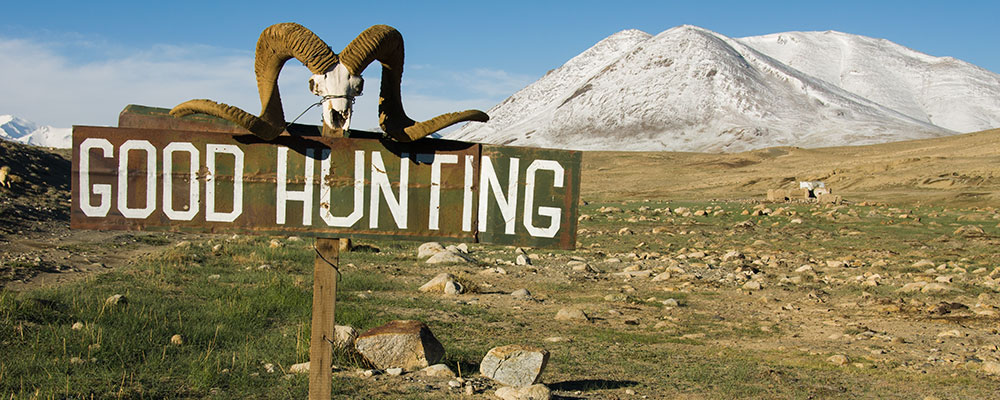When it comes to gemology, whether it is practiced in the lab or jewelry store, the importance of traveling to the source cannot be emphasized enough. Not only is information more accurate at the source, but the experiences will also make you a better salesperson.
Travel for Gems • Seeking the Mother Lode Abroad
Seek knowledge, even unto China. Islamic maxim
2006 – Read the headlines. Boo! International travel is undertaken only by the clinically insane or those with years of Special Ops experience under their bandoliers. Turn on the tube. Boo! The newspapers are correct – planet earth is one giant pool of war, disease and pestilence. If the pox or pollution don't gettcha, al Qaeda is close behind. As Lou Reed sang: "You've got a black .38 and a gravity knife. You still have to ride the train."
Lou was singing about the New York subways. Having braved those dangerous tunnels, we feel qualified to discuss what some might regard as a similar peril: foreign travel.
In our business, travel is not just recommended, but should be de rigueur. Fact is that those pretty little things worn in Carmel and Cannes are imports from the furthest reaches of the globe. But because of the perceived dangers, some in our business are content to sit back and let others bring it on home. This is a pity, for they are missing out on one of the most rewarding aspects of our business, that of visits to foreign gem-producing localities.

Getting to the mines is sometimes arduous, as this photo taken on the road below Tajikistan's Kuh-i-Lal spinel mines shows. But the rewards of such travel cannot be overstated. Photo © Richard W. Hughes.
Of course, the road to the mines does not always lead to lands of milk and honey. During this past summer (2006) in Tajikistan, RWH watched as one travel companion retched out the window of his vehicle (giardia?); days earlier another had passed out on the floor of a yurt (malaria?), while a third had rushed into the Murghab governor's mansion with a panic-stricken grimace that suggested breakfast was near detonation (liquid bomb?). Similarly, JK will never forget that evening in Thailand when, as he merrily chowed down on seafood near Chanthaburi, a dozen of his fellow diners were carted away in ambulances. Foreign travel to distant places can have its downside. Despite the old saw, getting there is not always half the fun.
To the source
Believe not what you hear, but only what you see, and of this, just half. Ancient maxim
Considering the above tales of woe, why would any jeweler with an IQ above single digits even think about venturing to such places?
We can offer a few reasons.
First, precious stones are found across the globe. Thus, every trip abroad is a potential tax write-off, if handled properly.
But there is more. This summer, we were able to undertake a detailed study of emerald and alexandrite from Russia's Malysheva mine, including an on-site visit by RH. Upon his return, RWH was visiting a dealer when a large "Russian" emerald was slid across the table. Because of his recent experiences, a quick look with the microscope was all that was needed to confirm the origin as Malysheva.
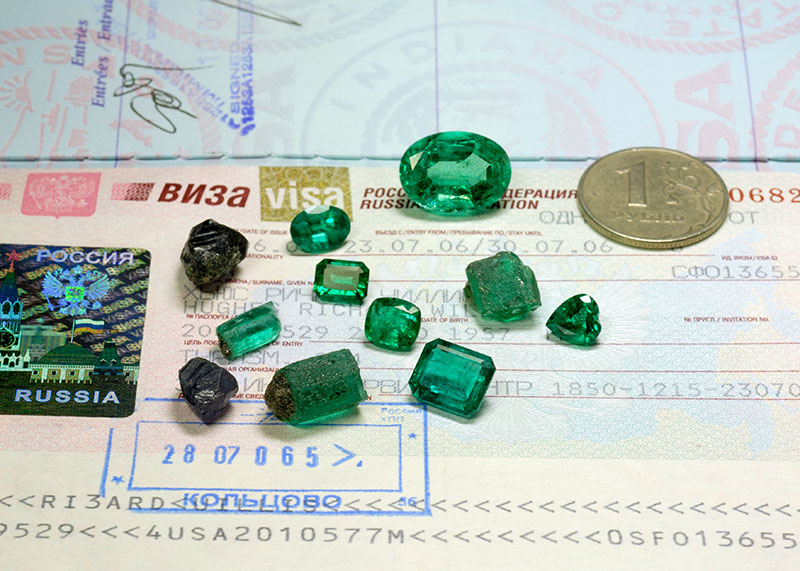
A selection of fine alexandrite and emerald rough from the famous Malysheva deposit outside Yekaterinburg, Russia. Photo © Wimon Manorotkul/Pala International; specimens courtesy of Tsar Emerald Corp.
How many jewelers realize that, while Sri Lanka does produce quantities of light blue sapphire, Serendib also produces rich blue stones that can stand with the finest from Burma or Kashmir? How many also understand that, in addition to the deep blues, Burma's Mogok Stone Tract also yields stones of both pale blue and yellow? Only jewelers that have personally visited a mine can fully understand the range of materials it produces. There is no substitute for direct experience.
Picture this: As you offer a fine colored gemstone to your client, you pull out a photo album showing you at the very place where such gems are mined. Even better, you may want to permanently display a photo or two of you at the source. This creates an aura of expertise that clearly sets you apart from your competitors.
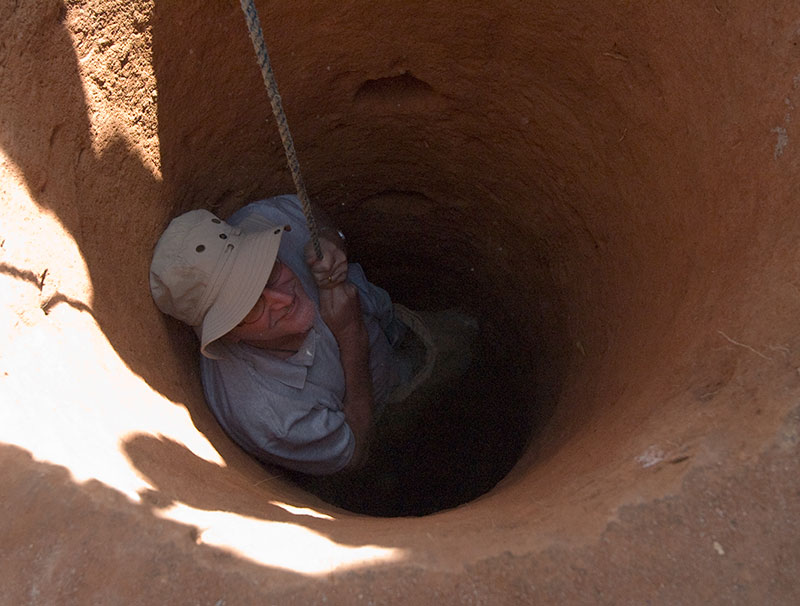
Richard Hughes descending into a gem pit in Madagascar. An album of photos such as this can help jewelers close sales because of the aura of expertise they establish. Photo: Vincent Pardieu.
For What It's Worth
Why is gold worth some twenty bucks an ounce? A thousand men, say, go searchin' for gold. After six months, one of them's lucky…. His find represents not only his own labor, but that of 999 others, to boot. That's 6000 months, 500 years, scramblin' over a mountain, goin' hungry and thirsty. An ounce of gold, mister, is worth what it is because of the human labor that went into the findin' and the gettin' of it. Walter Houston, Treasure of the Sierra Madre, 1948
But pox on the tax write-offs and photo ops; there are bigger reasons to visit the source. Imagine sitting for hours in the sweltering Brazilian bush watching two miners muscle spade after spade of earth out of an ever-deeper hole. Getting up to leave, you take stock of the day's finds – one colorless topaz and a fractured aquamarine.
Or take a family of miners near Ilakaka, Madagascar. When their production from the past two days' work is displayed, the tiny pile of stones does not fill even half a palm – of a child. At a nearby mechanized mine, despite machinery and a crew of a dozen, cleaning out the jig yields just a few dozen sapphires, none of which will cut a stone above two carats.
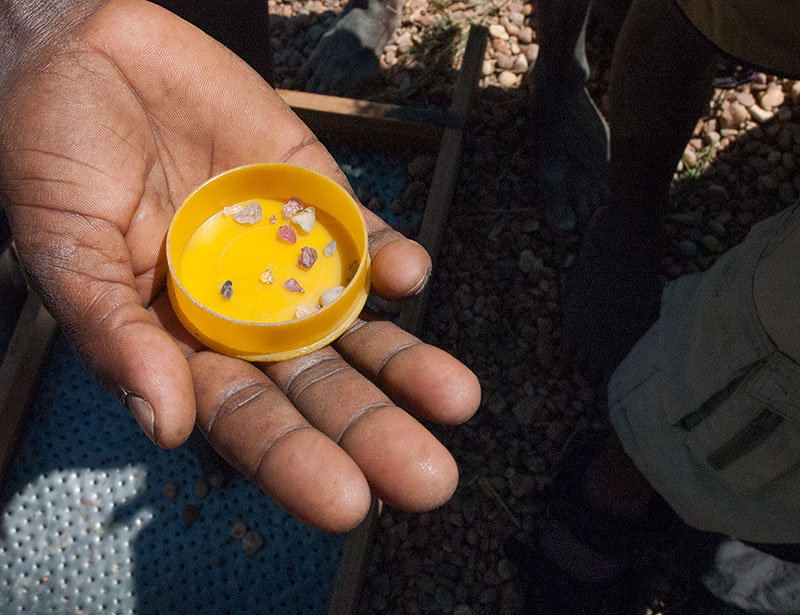
Handful of gem rough near Ilakaka, Madagascar. A family worked several days for these meager finds, illustrating just how rare fine gems are. Photo © Richard W. Hughes.
These are events we have personally witnessed, humbling experiences that drive home the true rarity of fine colored stones (not to mention the difficulty often encountered in bringing them to market). When you have seen this with your own eyes, you can explain the cost of your gems with both honesty and authority.
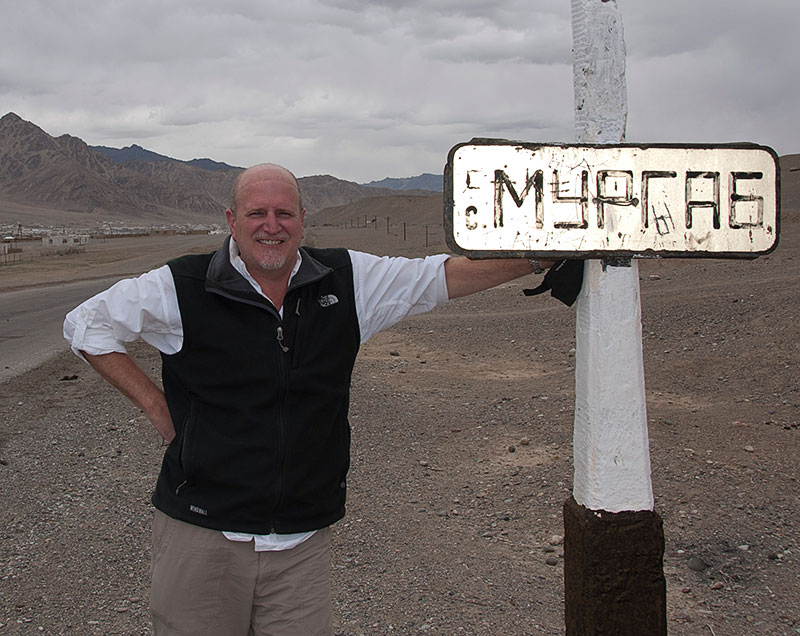
Richard Hughes on the outskirts of Murgab, in the remote Badakhshan region of Tajikistan. Imagine a photo of you next to the sign. Photo © Richard W. Hughes.
Bringin' It On Home
Now let us clue you in on a secret. The most important reason to visit far-flung locales has absolutely nothing to do with stones. Watch the world via the evening news and you're bound to come away with a negative impression. Everyday kindness rarely makes the cut. And yet it exists across the globe. We have experienced it wherever our feet have led us.
Witness the photograph at right. As RWH was traveling through Badakhshan in July 2006, his party paused on the roadside to rest. A Tajik girl soon appeared, armed with a bottle of fresh fermented milk. Approaching the vehicle, she smiled shyly, extended it to us and then walked away. Could this be a plot? The Afghan border was less than a mile away. Throwing caution to the wind, we drank the milk, and survived.
Some days later, just after descending from a tough climb to the Kuh-i-Lal spinel mines, two Wakhi girls skipped down the trail carrying an urn. Stopping, they opened it and offered us generous helpings of their fresh goat cheese. In one of the poorest regions of the world, they were not after money, but simply happy to share what they had with visitors from abroad. When was the last time we treated foreigners with similar grace and decency?
Hate and war become more difficult when a land and a people are more than abstractions, more than just electrons on a screen. By personally visiting other lands, we learn to better appreciate the values that tie us together.
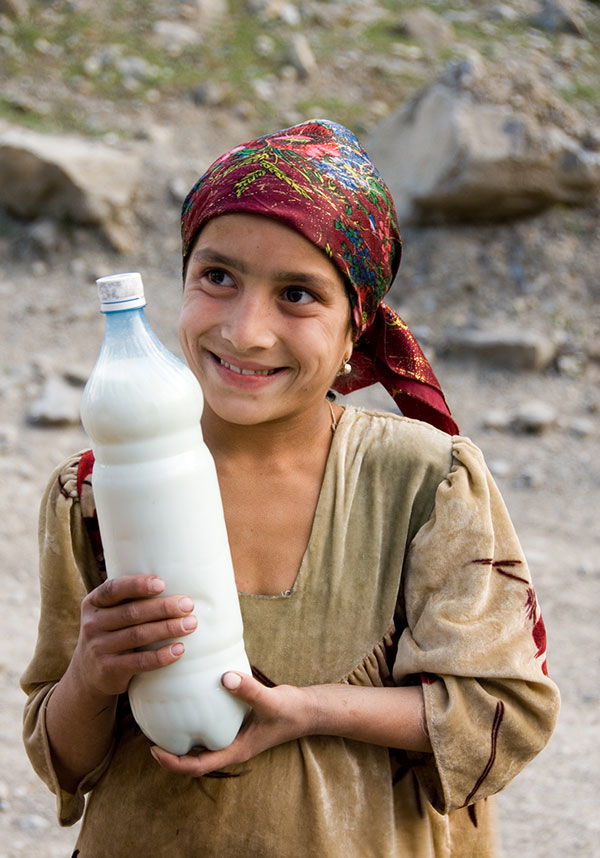
Got milk? A Tajik girl offers fermented milk to weary travelers in the remote Badakhshan region of Tajikistan. Photo © Richard W. Hughes.
Moonwalk
All who walk this earth are born under the same moon. Our shared humanity is far greater than differences in language, culture or religion. This lesson is the true mother lode of foreign travel, more precious than any stone we might unearth. Grasp this simple concept and, wherever you touch down, it will always be a land of milk and honey.
And what of those dangerous New York subways? They are also under the same moon. When Manhattan's tunnels were excavated in the 19th Century, gem garnets were found.
So fear not. Go forth and explore this magical planet. Seek knowledge, even unto Manhattan!

About the authors
Richard W. Hughes is one of the world’s foremost experts on ruby and sapphire. The author of several books and over 170 articles, his writings and photographs have appeared in a diverse range of publications, and he has received numerous industry awards. Co-winner of the 2004 Edward J. Gübelin Most Valuable Article Award from Gems & Gemology magazine, the following year he was awarded a Richard T. Liddicoat Journalism Award from the American Gem Society. In 2010, he received the Antonio C. Bonanno Award for Excellence in Gemology from the Accredited Gemologists Association. The Association Française de Gemmologie (AFG) in 2013 named Richard as one of the fifty most important figures that have shaped the history of gems since antiquity. In 2016, Richard was awarded a visiting professorship at Shanghai's Tongji University. 2017 saw the publication of Richard's Ruby & Sapphire: A Gemologist's Guide, arguably the most complete book ever published on a single gem species and the culmination of nearly four decades of work in gemology.
John Koivula is the author of the magnificent Photoatlas of Inclusions in Gemstones, Vols. 1–3, along with several other books and over 800 articles. He is currently Chief Research Gemologist at the Gemological Institute of America and is the world's foremost gem photomicrographer. John was also the scientific advisor to the famous MacGyver television series. Many of his books and enlargements of his images are available through microWorldofGems.com.
Notes
This article appeared in the Fall 2006 issue of the American Gem Society's Spectra magazine, as part of our regular "Elemental" column.

